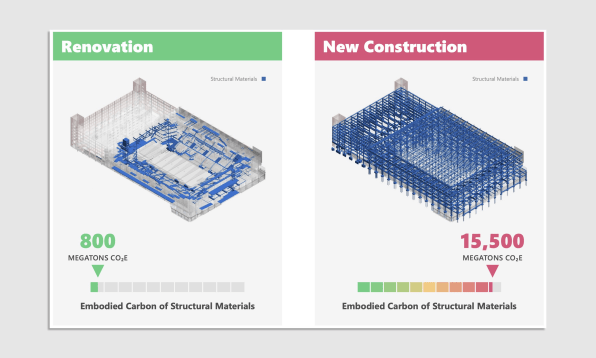New buildings are terrible for the environment. This arena is proof
When the owners of Baltimore’s CFG Bank Arena decided it was time to bring the 1960s-era basketball and concert venue into the 21st century, they bucked the common trend and decided against building a new facility. Instead, they would renovate what was already there.
A recent analysis of the project shows this renovation approach has had impressive environmental ramifications. Compared to tearing down the old arena and building a new one, the renovation saved 90% of structural steel and 95% of embodied carbon emissions.

“People actually asked us to double-check our numbers, which we did because the saving was so significant,” says Patti Harburg-Petrich, a principal at the engineering firm Buro Happold, which led the analysis.
Renovating eliminated the need for an estimated 3,500 tons of steel, 25,000 cubic yards of concrete, and 1.45 million gallons of water, according to the analysis. The project’s embodied carbon, or the amount of emissions that result from the production of building materials and construction, was a tiny fraction of what it would have been if the building were newly constructed.
“There is a huge opportunity to save carbon by taking a look at what building infrastructure we already have and ways to make it usable for the way we live our lives today,” Harburg-Petrich says.

The project was led by the Oak View Group, a development company that is making a name for itself with this kind of material-sensitive stadium renovation. Another recent project updated an arena built for the 1962 World’s Fair in Seattle into the world’s first net-zero carbon stadium.
But these projects are still outliers, at least for the time being. “What happens in the sports world is oftentimes the old venue is deemed not sufficient anymore. It’s not world-class, so it gets demolished and a new facility gets built instead,” Harburg-Petrich says, noting that CFG Bank Arena “is a great case study that shows you can create a world-class venue in an existing building.”

The renovation was not a total environmental free pass, though, and Buro Happold’s analysis estimates that the relatively small amount of new structural material required for the renovation has an embodied carbon footprint of about 800 megatons. The analysis considered only the structural elements of the stadium, not the carbon emissions that will result from new mechanical systems or interior finishes.
Even so, Harburg-Petrich says, the numbers are a strong argument for considering renovation of existing structures, whether large arenas or more modest office and residential buildings. “There are massive savings that can be realized by taking this approach,” she says. “We’re at a point where we have to be taking a look at this if we’re going to have any hope of curbing the climate emergency.”
(23)



